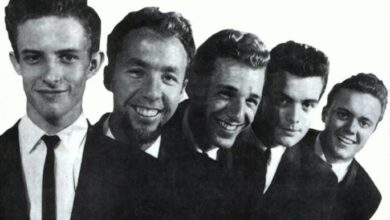The Tremeloes Delivered A Lively And Timeless Rendition Of “Here Comes My Baby”
In the vibrant tapestry of 1960s British pop music, few songs encapsulate the era’s exuberance and melodic charm like The Tremeloes’ 1967 hit, “Here Comes My Baby.” This track not only marked a significant milestone in the band’s career but also showcased the dynamic interplay between songwriters and performers during a transformative period in music history.
The origins of “Here Comes My Baby” trace back to the prolific British singer-songwriter Cat Stevens. In 1966, Stevens penned this tune, infusing it with his signature introspective lyricism. However, the song’s journey to prominence was not straightforward. Initially shelved in favor of Stevens’ debut single, “I Love My Dog,” “Here Comes My Baby” awaited its moment in the spotlight.
Enter The Tremeloes, an English beat group hailing from Dagenham, Essex. Formed in 1958, they initially performed as Brian Poole and the Tremeloes, drawing inspiration from Buddy Holly and the Crickets. Their early years were marked by a series of lineup changes and a relentless pursuit of musical identity.
A pivotal moment arrived in 1962 when Decca Records faced a choice between signing two emerging bands: The Tremeloes and a relatively unknown group from Liverpool called The Beatles. Opting for The Tremeloes, partly due to their proximity to London, Decca set the stage for the band’s initial brush with fame.
With Brian Poole as the frontman, the band achieved early success with covers like “Twist and Shout” and “Do You Love Me,” the latter reaching number one on the UK Singles Chart in 1963. Despite these achievements, internal dynamics shifted, leading to Poole’s departure in 1966. This transition prompted the remaining members—Alan Blakley, Rick Westwood, Dave Munden, and new bassist Len “Chip” Hawkes—to redefine their sound and image.
Embracing a more contemporary approach, The Tremeloes seized the opportunity to record “Here Comes My Baby.” Released as a single in January 1967, their rendition transformed Stevens’ melancholic undertone into an upbeat, infectious pop anthem. The band’s harmonious vocals and energetic instrumentation resonated with audiences, propelling the song into the top ten of the UK charts and reaching number 13 on the US Billboard Hot 100.
The success of “Here Comes My Baby” was a testament to The Tremeloes’ adaptability and musical prowess. It also highlighted the symbiotic relationship between songwriters and performers, with Stevens benefiting from the song’s popularity, which, in turn, bolstered his reputation as a songwriter.
Following this triumph, The Tremeloes continued to ride the wave of success with hits like “Silence Is Golden,” a poignant ballad that showcased their versatility and depth. Their ability to navigate the evolving musical landscape of the late 1960s ensured their place in the annals of British pop history.
“Here Comes My Baby” also found its way into popular culture, featuring in films and inspiring numerous cover versions. Notably, the song appeared in the 1998 film “Rushmore,” introducing it to a new generation and cementing its status as a timeless classic.
The enduring appeal of “Here Comes My Baby” lies in its universal theme of unrequited love, delivered with a buoyant melody that belies its lyrical content. This juxtaposition creates a compelling listening experience that continues to captivate audiences decades after its initial release.
Reflecting on The Tremeloes’ broader impact, their success with “Here Comes My Baby” exemplifies the band’s significant role in the British Invasion—a movement that saw UK bands achieve unprecedented popularity in the United States. Their contributions helped pave the way for future British artists seeking transatlantic acclaim.
In the years following their peak, The Tremeloes experienced various lineup changes and shifts in musical direction. However, the legacy of “Here Comes My Baby” endures, serving as a reminder of a time when catchy melodies and heartfelt lyrics dominated the airwaves.
The song’s influence is evident in its numerous covers by artists across genres, each bringing their unique interpretation while honoring the original’s spirit. This adaptability speaks to the song’s robust composition and its resonance with diverse audiences.
In conclusion, “Here Comes My Baby” stands as a shining example of 1960s pop craftsmanship. The Tremeloes’ spirited rendition transformed Cat Stevens’ composition into a chart-topping hit that continues to inspire and delight listeners. Its enduring legacy is a testament to the song’s quality and the band’s place in music history.
As we revisit this classic track, we’re reminded of the enduring power of music to capture the complexities of human emotion, all while providing a soundtrack to our lives. “Here Comes My Baby” remains a cherished gem in the rich tapestry of popular music.
For those wishing to experience the infectious energy of The Tremeloes’ performance, the original 1967 rendition of “Here Comes My Baby” is available on various music platforms, offering a delightful journey back to a golden era of pop music.
In the ever-evolving landscape of music, songs like “Here Comes My Baby” serve as enduring beacons, reminding us of the timeless appeal of well-crafted melodies and heartfelt storytelling. The Tremeloes’ contribution to this legacy is both significant and enduring, ensuring their place in the pantheon of pop music greats.
As we listen to “Here Comes My Baby” today, its cheerful melody and relatable lyrics continue to resonate, proving that great music transcends time, touching the hearts of listeners across generations.
In the end, “Here Comes My Baby” is more than just a song; it’s a testament to the enduring power of music to uplift, connect, and inspire. The Tremeloes’ rendition remains a timeless classic, a joyful expression of the universal human experience.



